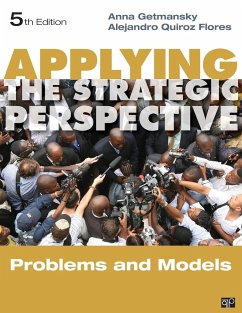- Broschiertes Buch
- Merkliste
- Auf die Merkliste
- Bewerten Bewerten
- Teilen
- Produkt teilen
- Produkterinnerung
- Produkterinnerung
International Relations in Perspective brings together a set of 43 classic and contemporary selections designed to introduce students to the most influential scholarship and key issues in the field. As balanced in its approach as Nau's introductory text, this distinctive reader gives equal space to realism, liberalism, constructivism and the work of critical theorists, more effectively reflecting the current state of scholarly debate. Organized to complement Perspectives on International Relations but flexible enough to use with any text or on its own, the collection covers a host of topics…mehr
Andere Kunden interessierten sich auch für
![Applying the Strategic Perspective Applying the Strategic Perspective]() Anna GetmanskyApplying the Strategic Perspective103,99 €
Anna GetmanskyApplying the Strategic Perspective103,99 €![Cases in International Relations Cases in International Relations]() Glenn HastedtCases in International Relations103,99 €
Glenn HastedtCases in International Relations103,99 €![Foreign Policy in Comparative Perspective Foreign Policy in Comparative Perspective]() Ryan K. BeasleyForeign Policy in Comparative Perspective162,99 €
Ryan K. BeasleyForeign Policy in Comparative Perspective162,99 €![The International Criminal Court from a Liberal Perspective The International Criminal Court from a Liberal Perspective]() Anna FuchsThe International Criminal Court from a Liberal Perspective15,95 €
Anna FuchsThe International Criminal Court from a Liberal Perspective15,95 €![A study of Organised Crime from an International Relations perspective A study of Organised Crime from an International Relations perspective]() Aida CiroA study of Organised Crime from an International Relations perspective32,99 €
Aida CiroA study of Organised Crime from an International Relations perspective32,99 €![Handbook of International Rivalries Handbook of International Rivalries]() David DreyerHandbook of International Rivalries194,99 €
David DreyerHandbook of International Rivalries194,99 €![The Middle East in International Relations The Middle East in International Relations]() Halliday FredThe Middle East in International Relations129,99 €
Halliday FredThe Middle East in International Relations129,99 €-
-
-
International Relations in Perspective brings together a set of 43 classic and contemporary selections designed to introduce students to the most influential scholarship and key issues in the field. As balanced in its approach as Nau's introductory text, this distinctive reader gives equal space to realism, liberalism, constructivism and the work of critical theorists, more effectively reflecting the current state of scholarly debate. Organized to complement Perspectives on International Relations but flexible enough to use with any text or on its own, the collection covers a host of topics including terrorism, human security, development, civil society, global governance, political economy, and more. The book features substantive chapter introductions that situate the readings and help students understand how selections speak to one another.
Hinweis: Dieser Artikel kann nur an eine deutsche Lieferadresse ausgeliefert werden.
Hinweis: Dieser Artikel kann nur an eine deutsche Lieferadresse ausgeliefert werden.
Produktdetails
- Produktdetails
- Verlag: CQ Press
- Seitenzahl: 770
- Erscheinungstermin: 15. Dezember 2009
- Englisch
- Abmessung: 235mm x 191mm x 41mm
- Gewicht: 1410g
- ISBN-13: 9781604269932
- ISBN-10: 1604269936
- Artikelnr.: 27855356
- Herstellerkennzeichnung
- Books on Demand GmbH
- In de Tarpen 42
- 22848 Norderstedt
- info@bod.de
- 040 53433511
- Verlag: CQ Press
- Seitenzahl: 770
- Erscheinungstermin: 15. Dezember 2009
- Englisch
- Abmessung: 235mm x 191mm x 41mm
- Gewicht: 1410g
- ISBN-13: 9781604269932
- ISBN-10: 1604269936
- Artikelnr.: 27855356
- Herstellerkennzeichnung
- Books on Demand GmbH
- In de Tarpen 42
- 22848 Norderstedt
- info@bod.de
- 040 53433511
Henry R. Nau has combined an outstanding career in the academic world with two opportunities to serve at the highest levels of the U.S. government. He brings this experience to bear in this textbook, integrating theory and practice with unprecedented clarity for understanding historical and contemporary issues in world affairs. Nau is currently professor of political science and international affairs at the Elliott School of International Affairs, George Washington University. He taught previously at Williams College and held visiting appointments at Johns Hopkins School of Advanced International Studies, Stanford University, and Columbia University. From 1977 to 1981, Nau served on the Board of Editors of the journal International Organization. He has received research grants from, among others, the Woodrow Wilson International Center for Scholars, the National Science Foundation, the Council on Foreign Relations, the Smith-Richardson Foundation, the Century Foundation, the Japan-U.S. Friendship Commission, the Hoover Institution, the Rumsfeld Foundation, and the Lynde and Harry Bradley Foundation. Nau served from 1975 to 1977 as special assistant to the undersecretary for economic affairs, Charles Robinson, in the U.S. Department of State. In that capacity he worked in the office of the Secretary of State Henry Kissinger to organize a major conference on science, technology, and foreign policy. For his service, he was awarded the State Department′s Superior Honor Award. From 1981 to 1983 Nau served as a senior staff member of the National Security Council responsible for international economic affairs. He was President Reagan's White House aide, or Sherpa, for the annual G7 economic summits in Ottawa (1981), Versailles (1982), and Williamsburg (1983), and for the special summit with developing countries in Cancun (1982). At those summits, the United States led a revival of the world economy from the stagflation and resource shortages of the 1970s to thirty years of 3+ percent growth per year, promoting the so-called Washington Consensus (originating in the Williamsburg Summit Communique) of lower inflation, freer markets and open trade. Nau wrote an account of these early years in The Myth of America's Decline (see below). Outside government, Nau continued his public service. From 1984 to 1990 he served on the U.S. Department of State's Advisory Committee on International Investment and as the U.S. member of the UN Committee for Development Planning. From 1989 to 2016, he directed the U.S.-Japan-South Korea Legislative Exchange Program, semiannual meetings among members of the U.S. Congress, the Japanese Diet, and the South Korean National Assembly. In 2016, the Japanese government awarded him the Order of the Rising Sun, Neck Ribbon with Gold Rays, the highest honor for academic leaders, in recognition of his work on this Exchange. From 1963 to 1965, Nau also served as a lieutenant in the 82nd Airborne Division at Fort Bragg, North Carolina.Nau's published books include, among others, Conservative Internationalism: Armed Diplomacy under Jefferson, Polk, Truman, and Reagan (Princeton University Press, 2013, and paperback with new preface, 2015); At Home Abroad: Identity and Power in American Foreign Policy (Cornell University Press, 2002); Trade and Security: U.S. Policies at Cross-Purposes (American Enterprise Institute, 1995); The Myth of America's Decline: Leading the World Economy into the 1990s (Oxford University Press, 1990); and National Politics and International Technology: Peaceful Nuclear Reactor Development in Western Europe (Johns Hopkins University Press, 1974). His most recent edited book is Worldviews of Aspiring Powers: Domestic Foreign Policy Debates in China, India, Iran, Japan, and Russia, coedited with Deepa M. Ollapally (Oxford University Press, 2012). Most recent articles and chapters in edited books include "Democratic Globalism," National Interest, November/December 2018; "Trump's Conservative Internationalism," National Review, August 2017; "America's International Nationalism," American Interest, January/February 2017; "The Difference Reagan Made," Claremont Review of Books, Winter 2016-2017; "How Restraint Leads to War: The Real Danger of the Iran Deal," Commentary (July/August, 2015); "Ideas Have Consequences: The Cold War and Today," International Politics 48 (July/September 2011): 460-81; "No Alternative to 'Isms, '" International Studies Quarterly 55, no. 2 (June 2011): 487-91; "The 'Great Expansion' The Economic Legacy of Ronald Reagan," in Reagan's Legacy in a Transformed World, edited by Jeffrey L. Chidester and Paul Kengor (Harvard University Press, 2015); "Scholarship and Policy-Making: Who Speaks Truth to Whom?," in The Oxford Handbook of International Relations, edited by Christian Reus-Smit and Duncan Snidal (Oxford University Press, 2008); and "Iraq and Previous Transatlantic Crises: Divided by Threat, Not Institutions or Values," in The End of the West? Crisis and Change in the Atlantic Order, edited by Jeffrey Anderson, G. John Ikenberry, and Thomas Risse (Cornell University Press, 2008). For Nau's personal website, see www.henryrnau.com
The Dilemma of Scientific Man
Japan, Asian-Pacific Security, and the Case for Analytical Eclecticism
Chapter 1: How to Think About International Relations: Perspectives and
Levels of Analysis
The Realist Critique
Realism and Complex Interdependence
Anarchy Is What States Make of It: The Social Construction of Power
Politics
Karl Marx
Thoroughly Modern Marx: Lights. Camera. Action. Das Kapital. Now.
The Level-of-Analysis Problem in International Relations
Chapter 2: Perspectives on World History: Change and Continuity
Historical Reality vs. Neo-realist Theory
The Fragmentation and Consolidation of International Systems
Intervention and International Order
Chapter 3: World War I: World on Fire
The Coming of the First World War: A Reassessment
The July Crisis and the Outbreak of World War I
Chapter 4: World War II: What Did War Happen Again?
The 1930s and the Origins of the Second World War
Selections from President Roosevelt and the Coming of the War, 1941: A
Study in Appearances and Realities
Chapter 5: The Origins and End of the Cold War
The Long Telegram
Telegram from the Soviet Ambassador to the United States, to the Soviet
Leadership
Reagan, Gorbachev, and the Completion of Containment
Deterrence and the End of the Cold War
Chapter 6: From 11/9-9/11: The World of the 1990s
The End of History?
The Clash of Civilization?
Great Power Politics in the Twenty-first Century
Chapter 7: Terrorism and the World after 9/11
Feminist Perspectives on 9/11
How Baida Wanted to Die
What China Will Want: The Future Intentions of a Rising Power
Us and Them: The Enduring Power of Ethnic Nationalism
Separatism¿s Final Country
Chapter 8: History of Globalization: Mercantilism, Pax Britannica, and Pax
Americana
Dominance and Leadership in the International Economy: Exploitation, Public
Goods, and Free Rides
Economic Interdependence and National Security in Historical Perspective
Chapter 9: How Globalization Works in Practice
The "Magic" of the Market
Selections from "Has Globalization Gone Too Far?"
Chapter 10: Trade, Investment, and Finance: Engines of Growth
The Economics of QWERTY
Global Imbalances and the Financial Crisis
Chapter 11: Miracle and Missed Opportunity: Development in Asia and Latin
America
From Miracle to Crisis to Recovery: Lessons from Four Decades of East Asian
Experience
An Empty Revolution: The Unfilled Promises of Hugo Chavez
Chapter 12: Foreign Aid and Domestic Governance: Development in Africa and
the Middle East
Towards the Rise of Women in the Arab World: Concepts and Problematic
Issues
Is Africäs Economy at a Turning Point?
The Making, and Unmaking, of a Child Soldier
Chapter 13: Global Inequality, Imperialism, and Injustice: A Critical
Theory Perspective
Carmen Miranda on My Mind: International Politics of the Banana
Dependent Capitalist Development in Latin America
Chapter 14: World Environment: Population, Pollution and Pandemics
Selection from "An Inconvenient Truth"
Is Humanity Losing the Global Warming Debate?
Chapter 15: Global Civil Society: Nonstate Actors and Basic Human Rights
Selection from "A New World Order"
Transitional Justice: Criminal Courts and Alternatives
Chapter 16: Global Governance: International and Regional Institutions
The Challenges of Global Governance
Regional Orders
Conclusion: Applying Perspectives and Levels of Analysis: The Case of the
Democratic Peace
The Kantian Peace in the Twenty-First Century
Japan, Asian-Pacific Security, and the Case for Analytical Eclecticism
Chapter 1: How to Think About International Relations: Perspectives and
Levels of Analysis
The Realist Critique
Realism and Complex Interdependence
Anarchy Is What States Make of It: The Social Construction of Power
Politics
Karl Marx
Thoroughly Modern Marx: Lights. Camera. Action. Das Kapital. Now.
The Level-of-Analysis Problem in International Relations
Chapter 2: Perspectives on World History: Change and Continuity
Historical Reality vs. Neo-realist Theory
The Fragmentation and Consolidation of International Systems
Intervention and International Order
Chapter 3: World War I: World on Fire
The Coming of the First World War: A Reassessment
The July Crisis and the Outbreak of World War I
Chapter 4: World War II: What Did War Happen Again?
The 1930s and the Origins of the Second World War
Selections from President Roosevelt and the Coming of the War, 1941: A
Study in Appearances and Realities
Chapter 5: The Origins and End of the Cold War
The Long Telegram
Telegram from the Soviet Ambassador to the United States, to the Soviet
Leadership
Reagan, Gorbachev, and the Completion of Containment
Deterrence and the End of the Cold War
Chapter 6: From 11/9-9/11: The World of the 1990s
The End of History?
The Clash of Civilization?
Great Power Politics in the Twenty-first Century
Chapter 7: Terrorism and the World after 9/11
Feminist Perspectives on 9/11
How Baida Wanted to Die
What China Will Want: The Future Intentions of a Rising Power
Us and Them: The Enduring Power of Ethnic Nationalism
Separatism¿s Final Country
Chapter 8: History of Globalization: Mercantilism, Pax Britannica, and Pax
Americana
Dominance and Leadership in the International Economy: Exploitation, Public
Goods, and Free Rides
Economic Interdependence and National Security in Historical Perspective
Chapter 9: How Globalization Works in Practice
The "Magic" of the Market
Selections from "Has Globalization Gone Too Far?"
Chapter 10: Trade, Investment, and Finance: Engines of Growth
The Economics of QWERTY
Global Imbalances and the Financial Crisis
Chapter 11: Miracle and Missed Opportunity: Development in Asia and Latin
America
From Miracle to Crisis to Recovery: Lessons from Four Decades of East Asian
Experience
An Empty Revolution: The Unfilled Promises of Hugo Chavez
Chapter 12: Foreign Aid and Domestic Governance: Development in Africa and
the Middle East
Towards the Rise of Women in the Arab World: Concepts and Problematic
Issues
Is Africäs Economy at a Turning Point?
The Making, and Unmaking, of a Child Soldier
Chapter 13: Global Inequality, Imperialism, and Injustice: A Critical
Theory Perspective
Carmen Miranda on My Mind: International Politics of the Banana
Dependent Capitalist Development in Latin America
Chapter 14: World Environment: Population, Pollution and Pandemics
Selection from "An Inconvenient Truth"
Is Humanity Losing the Global Warming Debate?
Chapter 15: Global Civil Society: Nonstate Actors and Basic Human Rights
Selection from "A New World Order"
Transitional Justice: Criminal Courts and Alternatives
Chapter 16: Global Governance: International and Regional Institutions
The Challenges of Global Governance
Regional Orders
Conclusion: Applying Perspectives and Levels of Analysis: The Case of the
Democratic Peace
The Kantian Peace in the Twenty-First Century
The Dilemma of Scientific Man
Japan, Asian-Pacific Security, and the Case for Analytical Eclecticism
Chapter 1: How to Think About International Relations: Perspectives and
Levels of Analysis
The Realist Critique
Realism and Complex Interdependence
Anarchy Is What States Make of It: The Social Construction of Power
Politics
Karl Marx
Thoroughly Modern Marx: Lights. Camera. Action. Das Kapital. Now.
The Level-of-Analysis Problem in International Relations
Chapter 2: Perspectives on World History: Change and Continuity
Historical Reality vs. Neo-realist Theory
The Fragmentation and Consolidation of International Systems
Intervention and International Order
Chapter 3: World War I: World on Fire
The Coming of the First World War: A Reassessment
The July Crisis and the Outbreak of World War I
Chapter 4: World War II: What Did War Happen Again?
The 1930s and the Origins of the Second World War
Selections from President Roosevelt and the Coming of the War, 1941: A
Study in Appearances and Realities
Chapter 5: The Origins and End of the Cold War
The Long Telegram
Telegram from the Soviet Ambassador to the United States, to the Soviet
Leadership
Reagan, Gorbachev, and the Completion of Containment
Deterrence and the End of the Cold War
Chapter 6: From 11/9-9/11: The World of the 1990s
The End of History?
The Clash of Civilization?
Great Power Politics in the Twenty-first Century
Chapter 7: Terrorism and the World after 9/11
Feminist Perspectives on 9/11
How Baida Wanted to Die
What China Will Want: The Future Intentions of a Rising Power
Us and Them: The Enduring Power of Ethnic Nationalism
Separatism¿s Final Country
Chapter 8: History of Globalization: Mercantilism, Pax Britannica, and Pax
Americana
Dominance and Leadership in the International Economy: Exploitation, Public
Goods, and Free Rides
Economic Interdependence and National Security in Historical Perspective
Chapter 9: How Globalization Works in Practice
The "Magic" of the Market
Selections from "Has Globalization Gone Too Far?"
Chapter 10: Trade, Investment, and Finance: Engines of Growth
The Economics of QWERTY
Global Imbalances and the Financial Crisis
Chapter 11: Miracle and Missed Opportunity: Development in Asia and Latin
America
From Miracle to Crisis to Recovery: Lessons from Four Decades of East Asian
Experience
An Empty Revolution: The Unfilled Promises of Hugo Chavez
Chapter 12: Foreign Aid and Domestic Governance: Development in Africa and
the Middle East
Towards the Rise of Women in the Arab World: Concepts and Problematic
Issues
Is Africäs Economy at a Turning Point?
The Making, and Unmaking, of a Child Soldier
Chapter 13: Global Inequality, Imperialism, and Injustice: A Critical
Theory Perspective
Carmen Miranda on My Mind: International Politics of the Banana
Dependent Capitalist Development in Latin America
Chapter 14: World Environment: Population, Pollution and Pandemics
Selection from "An Inconvenient Truth"
Is Humanity Losing the Global Warming Debate?
Chapter 15: Global Civil Society: Nonstate Actors and Basic Human Rights
Selection from "A New World Order"
Transitional Justice: Criminal Courts and Alternatives
Chapter 16: Global Governance: International and Regional Institutions
The Challenges of Global Governance
Regional Orders
Conclusion: Applying Perspectives and Levels of Analysis: The Case of the
Democratic Peace
The Kantian Peace in the Twenty-First Century
Japan, Asian-Pacific Security, and the Case for Analytical Eclecticism
Chapter 1: How to Think About International Relations: Perspectives and
Levels of Analysis
The Realist Critique
Realism and Complex Interdependence
Anarchy Is What States Make of It: The Social Construction of Power
Politics
Karl Marx
Thoroughly Modern Marx: Lights. Camera. Action. Das Kapital. Now.
The Level-of-Analysis Problem in International Relations
Chapter 2: Perspectives on World History: Change and Continuity
Historical Reality vs. Neo-realist Theory
The Fragmentation and Consolidation of International Systems
Intervention and International Order
Chapter 3: World War I: World on Fire
The Coming of the First World War: A Reassessment
The July Crisis and the Outbreak of World War I
Chapter 4: World War II: What Did War Happen Again?
The 1930s and the Origins of the Second World War
Selections from President Roosevelt and the Coming of the War, 1941: A
Study in Appearances and Realities
Chapter 5: The Origins and End of the Cold War
The Long Telegram
Telegram from the Soviet Ambassador to the United States, to the Soviet
Leadership
Reagan, Gorbachev, and the Completion of Containment
Deterrence and the End of the Cold War
Chapter 6: From 11/9-9/11: The World of the 1990s
The End of History?
The Clash of Civilization?
Great Power Politics in the Twenty-first Century
Chapter 7: Terrorism and the World after 9/11
Feminist Perspectives on 9/11
How Baida Wanted to Die
What China Will Want: The Future Intentions of a Rising Power
Us and Them: The Enduring Power of Ethnic Nationalism
Separatism¿s Final Country
Chapter 8: History of Globalization: Mercantilism, Pax Britannica, and Pax
Americana
Dominance and Leadership in the International Economy: Exploitation, Public
Goods, and Free Rides
Economic Interdependence and National Security in Historical Perspective
Chapter 9: How Globalization Works in Practice
The "Magic" of the Market
Selections from "Has Globalization Gone Too Far?"
Chapter 10: Trade, Investment, and Finance: Engines of Growth
The Economics of QWERTY
Global Imbalances and the Financial Crisis
Chapter 11: Miracle and Missed Opportunity: Development in Asia and Latin
America
From Miracle to Crisis to Recovery: Lessons from Four Decades of East Asian
Experience
An Empty Revolution: The Unfilled Promises of Hugo Chavez
Chapter 12: Foreign Aid and Domestic Governance: Development in Africa and
the Middle East
Towards the Rise of Women in the Arab World: Concepts and Problematic
Issues
Is Africäs Economy at a Turning Point?
The Making, and Unmaking, of a Child Soldier
Chapter 13: Global Inequality, Imperialism, and Injustice: A Critical
Theory Perspective
Carmen Miranda on My Mind: International Politics of the Banana
Dependent Capitalist Development in Latin America
Chapter 14: World Environment: Population, Pollution and Pandemics
Selection from "An Inconvenient Truth"
Is Humanity Losing the Global Warming Debate?
Chapter 15: Global Civil Society: Nonstate Actors and Basic Human Rights
Selection from "A New World Order"
Transitional Justice: Criminal Courts and Alternatives
Chapter 16: Global Governance: International and Regional Institutions
The Challenges of Global Governance
Regional Orders
Conclusion: Applying Perspectives and Levels of Analysis: The Case of the
Democratic Peace
The Kantian Peace in the Twenty-First Century








